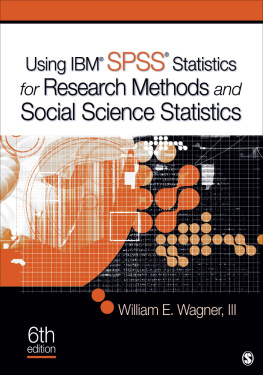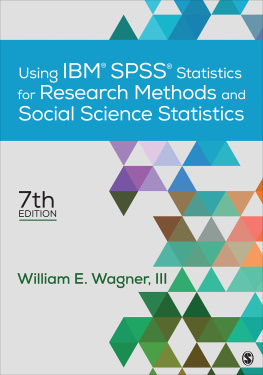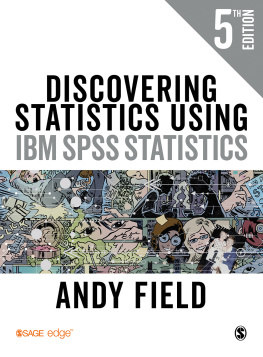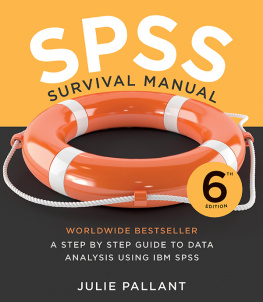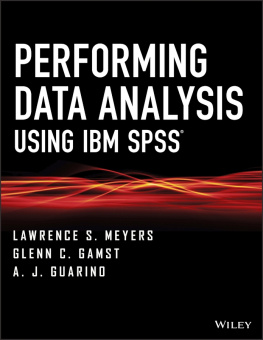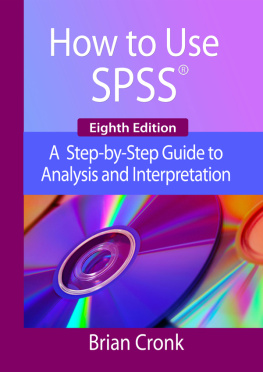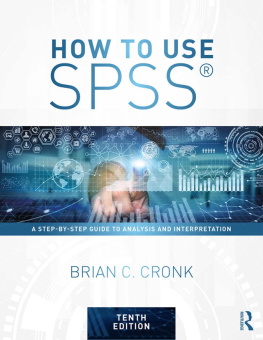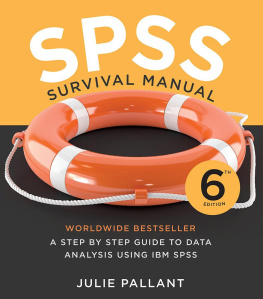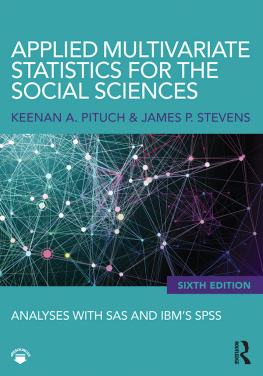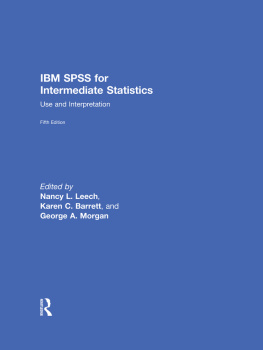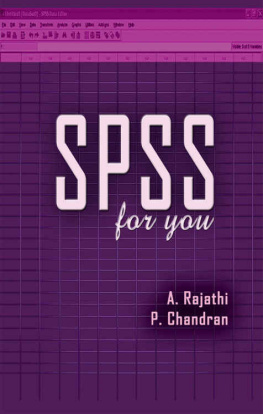PRAISE FOR A CRASH COURSE IN SPSS FOR WINDOWS
Do you think SPSS manuals are generally far more cumbersome than they need to be? Do your students find learning SPSS for Windows from a manual a timeconsuming ordeal? A Crash Course in SPSS for Windows enables students to learn the package quickly and painlessly, provided they have some background knowledge of statistics. Why use A Crash Course in SPSS for Windows? This clear, explicit and user-friendly text enables most users to learn the basics comfortably within ten hours and makes it enjoyable.
Gnist Akademika
I have taken several classes that have used SPSS. When I started taking these classes I had little to no knowledge about statistics. It was extremely frustrating to understand the texts that were put out by SPSS. After reviewing this book, I have a clear understanding of how to use SPSS. It made the difficult task of understanding the output simple. SPSS is intuitive, in the sense that it is simple to pick a test and run it. However, understanding which particular piece of data is of interest to you is not intuitive. This book helps clear up the jungle of data that you have to trek through to come up with your conclusion.
Amazon.com reader
Reading the book is made considerably easier due to its neat layout and a contents page which lets the reader turn to the appropriate section with ease. The chapters all have a cover page explaining what the chapter will include and when reading through the chapters the readers eye is immediately drawn to the key points which are highlighted using a darker font. Bullet points allow the reader to follow the steps to figuring out the procedure with considerable ease and they are written in a way that is coherent and makes the process less complex.
With its spacious layout making it easy to read and the ring binder finish allowing pages to be accessed more effectively this book is successful in demonstrating how to use SPSS to interpret, analyse, and draw up results using a variety of different tests.
Marianne Bigg, BPS Student Rep.
This textbook provides an inexpensive and quick way to become familiar with SPSS. True to its title, the book presents an abbreviated introduction to SPSS without being brusque. The authors expect novices to be able to complete the book in under 10 hours. For those familiar with the Windows operating system and spreadsheet programs (e.g., Excel), the material can completed in a few hours less... overall, the book delivers a quick and easy to follow introduction to SPSS suitable for novices.
J. Wade Davis in The American Statistician
This fourth edition first published 2008
2008 Andrew M. Colman and Briony D. Pulford
Edition history: Blackwell Publishing Ltd (1e, 2000; 2e 2003, 3e, 2006)
Blackwell Publishing was acquired by John Wiley & Sons in February 2007. Blackwells publishing program has been merged with Wileys global Scientific, Technical, and Medical business to form Wiley-Blackwell.
Registered Office
John Wiley & Sons Ltd, The Atrium, Southern Gate, Chichester, West Sussex, PO19 8SQ, United Kingdom
Editorial Offices
350 Main Street, Malden, MA 021485020, USA
9600 Garsington Road, Oxford, OX4 2DQ, UK
The Atrium, Southern Gate, Chichester, West Sussex, PO19 8SQ, UK
For details of our global editorial offices, for customer services, and for information about how to apply for permission to reuse the copyright material in this book please see our website at www.wiley.com/wiley-blackwell.
The right of Andrew M. Colman and Briony D. Pulford to be identified as the author of this work has been asserted in accordance with the Copyright, Designs and Patents Act 1988.
All rights reserved. No part of this publication may be reproduced, stored in a retrieval system, or transmitted, in any form or by any means, electronic, mechanical, photocopying, recording or otherwise, except as permitted by the UK Copyright, Designs and Patents Act 1988, without the prior permission of the publisher.
Wiley also publishes its books in a variety of electronic formats. Some content that appears in print may not be available in electronic books.
Designations used by companies to distinguish their products are often claimed as trademarks. All brand names and product names used in this book are trade names, service marks, trademarks or registered trademarks of their respective owners. The publisher is not associated with any product or vendor mentioned in this book. This publication is designed to provide accurate and authoritative information in regard to the subject matter covered. It is sold on the understanding that the publisher is not engaged in rendering professional services. If professional advice or other expert assistance is required, the services of a competent professional should be sought.
Library of Congress Cataloging-in-Publication Data
Colman, Andrew M.
A crash course in SPSS for Windows: updated for versions 14, 15, and 16/Andrew M. Colman and Briony D. Pulford. 4th ed.
p. cm.
Includes bibliographical references and index.
ISBN 978-1-4051-8402-1 (pbk.: alk. paper) 1. SPSS for Windows.
2. Social sciencesStatistical methodsComputer programs. I. Pulford, Briony. II. Title.
HA32.C63 2008
519.5028553dc22
2008017213
Preface to the Fourth Edition
With the help of this Crash Course, you should be able to learn SPSS quickly and painlessly, provided that you have some background knowledge of statistics. SPSS is not hard to use, and we can explain the basics to you without fuss. In our experience, busy people dislike spending large amounts of time learning computer applications. We believe that most SPSS manuals are far more cumbersome than they need to be. Learning SPSS with more conventional manuals is time-consuming and quite an ordeal.
This book is designed to make things quicker and easier. It grew out of a specific need, and it proved popular because it filled a gap in the market, although since the first edition, some flattering imitations have appeared in print. Almost all computational examples in our Crash Course are taken from real data in published research, rather than hypothetical examples such as are found in most statistics and computing books, but we have chosen small data sets to spare you the time and boredom involved in inputting data.
The contents and presentation of the book were greatly improved by usability trials that we carried out for the first edition. We sent a rough draft of the book to 15 students and academics at a dozen different universities, all of whom had expressed a wish to learn SPSS but had no previous knowledge or experience of it, and we asked them to work through the course carefully, making notes of everything that they found unclear or felt could be improved, and keeping a record of the time taken to complete the course. The results were enormously helpful. Our readers came up with comments, criticisms, and useful suggestions for every chapter. These responses enabled us to produce a revised version incorporating a vast number of improvements, big and small, and we know of no other SPSS manual that has had the benefit of such systematic feedback from the end-users for whom it is intended. The time taken to complete the course in the usability trials ranged from five and a half to nine hours, with a mean of just under seven hours (6 hours 52 minutes, to be exact), usually spread over several sessions. The content has expanded slightly since then, but most readers should still be able to complete the course within about 10 hours.
The first two chapters are written with complete beginners in mind. They describe the basic features of SPSS and explain from the very beginning how to get it up and running. If you already have some familiarity with Windows-based applications, then we suggest that you just skim these introductory chapters, but do make a note of the less familiar information in sections 2.3 and 2.4. Chapter 3 describes how data are loaded and printed in SPSS, and this will also be fairly familiar territory to many readers. The remaining chapters describe the most widely used statistical techniques and graphic facilities available in SPSS.



